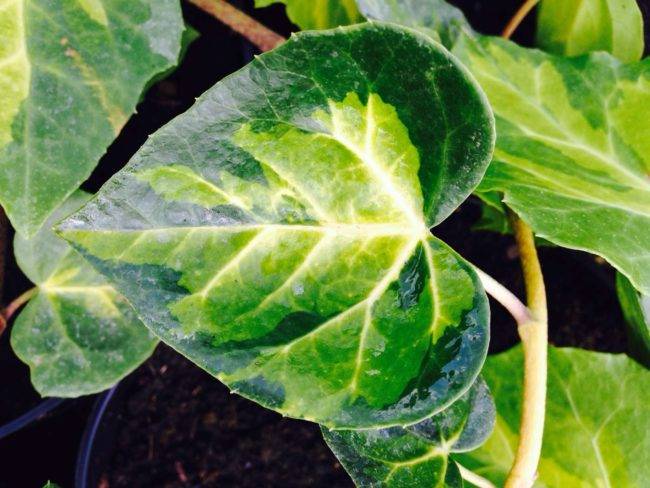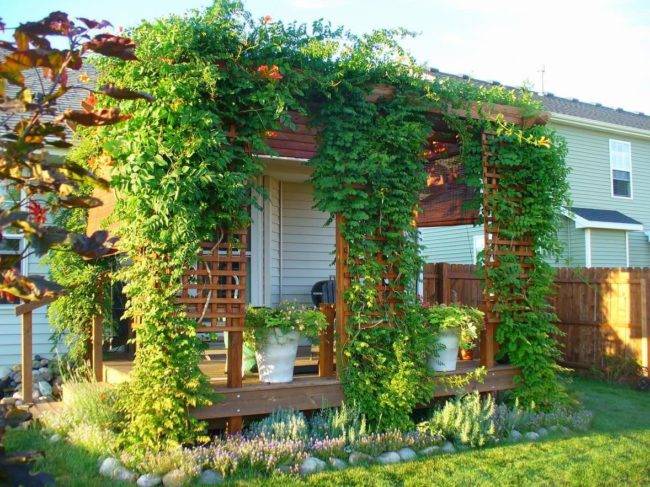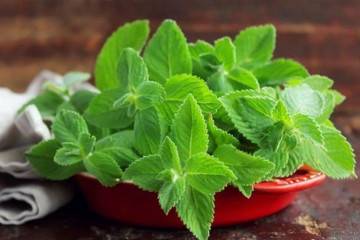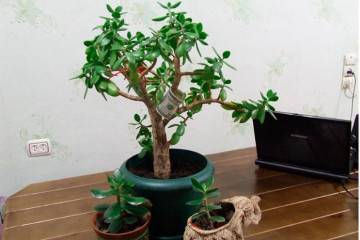Ivy garden evergreen frost-resistant - how to plant in the garden
Content:
Plants serve as a source of oxygen, they are used as a decorative decoration. Ivy can be planted in an apartment, but it will look great on the street near a house or summer cottage. The fast-growing shoots will help wrap around buildings, fences, and trees. In order for the evergreen vine to please the owners with a beautiful view, you need to know the rules of care and reproduction.
Description of garden ivy (Hedera)
This type is the most common due to its increased resistance to cold and unpretentiousness. Ivy can be grown as a houseplant, but it looks great in the garden too.
Garden ivy - evergreen and frost-resistant
In Russia, common winter-hardy ivy is popular. The first two years have seen slow growth. The plant is used as a ground cover crop and for landscaping vertical structures.
Characteristics of garden evergreen ivy
Climbing vine shoots are capable of reaching 30 m. It is firmly attached to a vertical wall or tree due to sucker roots.
In total, there are 15 species of ivy and over 1000 varieties. The leaves can vary in color, size and shape, depending on the variety.
The variegated species are given some decorative effect by the white edging of the leaves, dark or light blotches compared to the main background. The leaves are dense to the touch with a smooth surface. October and September are considered the flowering period of the plant. Light green umbrella-shaped inflorescences.
Popular species and varieties
The plant is a thermophilic crop, therefore it is most often found in the south. Some frost-hardy vines grow in temperate climates. Here are the main types of ivy:
- ordinary. It is the most common plant used for outdoor and indoor planting. The leaves are medium-sized, have a five or three-toed shape. The foliage may have blotches or shine, depending on the variety. Growth is moderate, up to 20 m in length, braiding nearby surfaces. Ivy is used for vertical landscaping of structures and buildings. Better to plant in partial shade. The most popular frost-resistant varieties are Goldhert, Mona Lisa, Eva, Sagittaefolia;
- Caucasian, or Colchis. It is a fast growing plant with large dark green leaves and strong shoots. Liana is able to braid the surface up to 30 m high, grows in the shade. Popular garden forms - Dentata Variegata, Arborescens;
- Crimean. Ivy is unpretentious, grows quickly, is resistant to cold and drought. As it grows, lignification of the shoots is noted, which entwine shrubs and trees. The length of an adult liana reaches up to 30 m, and the trunk in a circle is up to 1 m.
Each species has its own characteristics and characteristics, but they are ideal for landscaping a garden.
Ivy care
The wind carries the whitefly, ticks, aphids, thrips, which are dangerous for ivy. Insecticides must be used as soon as the pests have been noticed on the leaves, stems.
Sometimes it is required to carry out a second procedure for getting rid of pests.
Ivy propagation by cuttings
It is recommended to use apical cuttings that can multiply quickly. To grow a seedling you need:
- Cut cuttings up to 10 cm long, which have at least one healthy knot.
- Plant in a pot or root in loose soil in a greenhouse, water.
- Transplant the ivy to a permanent location while forming a sufficient number of roots.
Preparing for winter
Low temperatures can have a detrimental effect on the plant, especially in the areas of the Middle Lane. Covering the soil with an additional layer of mulch will allow you to save the vine. In winter, it is recommended to pour snow up to 30 cm high on the soil. Experienced flower growers cover whips growing vertically with plastic or burlap.
Possible problems in growing garden ivy evergreen outdoors
When growing a plant, thrips, whiteflies, aphids, ticks and windborne insects are the most dangerous. When pests appear on the leaves or stem, you must immediately start treating perennial street ivy with insecticides. Liana should be sprayed with karbofos or actellik diluted in water. Sometimes it takes several irrigations to completely destroy the parasites.
The affected areas must be removed so that the infection does not spread to the stems and leaves that are nearby.
Violation of the rules of care
There are several signs by which you can find out about the presence of pests or diseases:
- yellow and dry leaves indicate an excess of fertilizers, moisture;
- the pallor of the plant indicates a lack of ultraviolet rays, so it should be transplanted from the shade to an area with good lighting;
- yellow foliage signals dryness of the soil, therefore, it is required to control watering;
- dry air leads to the falling of leaves, spraying with water from a hose will remove the problem.
How to plant street ivy
Planting an outdoor plant differs slightly from an indoor plant. You need to know all the nuances of the care and reproduction of evergreen vines before planting ivy at home.
Preparation and planting of purchased planting material
The seedlings are planted at a distance of 50 cm from each other to facilitate future care. The hole should accommodate ivy root and drainage. When planting, the soil is compacted and abundantly moistened. Air must be supplied to the rhizome, therefore, it is required to control the state of the upper soil layer. It can be loosened or covered with peat, sawdust, leaves, etc.
Ivy breeding conditions
It is not difficult to plant greenery with a climbing plant if you immediately purchase new seedlings. But the garden vine can be propagated independently, although the task is not very simple. The main thing is to choose the best way and follow all the transplant rules.
The main methods of propagation of plants that grow in open ground near the house or in the country:
- rooting of cuttings;
- cuttings;
- separation of perennial shrubs.
Old ivy can be detached without the need to completely dig it out.Part of the vines should be removed around the perimeter, using these branches as independent seedlings.
Cuttings are the main breeding method for ivy
The twigs of a houseplant take root quickly, so plain water is often used. For garden vines, different methods are used, but grafting remains the main one. The ivy scourges begin to take root after a few weeks.
It is recommended to use annual shoots, stem and apical cuttings are suitable. The former require the separation of a whole shoot with 8-10 leaves. Select not too small apical cuttings, 10-20 cm long, which must be cut at an angle. The lower two pairs of leaves are cut.
Plant cuttings can be rooted in:
- mixtures of sand and peat;
- water;
- soil with a high sand content;
- solution of rooting stimulants.
It is not necessary to cover the ivy and create conditions with the optimal temperature regime. The main thing is to stably maintain moist soil. Covering with a cap slightly speeds up rooting, the same effect can be achieved using growth stimulants.
The apical cuttings must be planted in the ground, deepening them to the first leaves. The average rooting period is 2-6 weeks, after which the vine can be transplanted to a permanent place.
Stem cuttings are laid horizontally on the soil surface. Shoots need to be pressed to a depth of 2 cm, leaving the leaves on top. Basically, the stem is left intact, but it can be divided into cuttings with one leaf node. Rooting time is 2 weeks, after which the tip of the shoot begins to grow intensively. Plants should be separated only after 2 weeks.
Rooting layers in ivy
The plant can be propagated by layering, like other types of climbing vines. Scourges located on the ground are able to take root on their own. This process can be stimulated to produce strong stems. Rooting cuttings is a very popular propagation method and is ideal for those looking for a few new plants.
Even for novice florists, the procedure will seem simple:
- In a small trench, it is necessary to lay the lower shoots of variegated garden ivy for growing vertically or along the perimeter for plants growing horizontally. Strong and long shoots are used for reproduction. To speed up rooting, it is necessary to make cuts on the branches.
- In the ground, the branches are fixed with staples, sprinkling them on top with a nutrient mixture or substrate.
- Stable humidity will allow you to maintain abundant watering first, and then regular moisture.
Do not rush to plant new stems after rooting. The next spring, you can separate new shoots as an independent plant and lipstick in a permanent place.
Preparation for planting in open ground
It is recommended to plant the plant in an elevated location without wind. A completely open area must be avoided because the leaves can be burned by direct ultraviolet rays. Better to choose partial shade.
The next step is to prepare the ground. The soil must be breathable and moist.
When buying an already grown seedling, you need to pay attention to its condition. A healthy plant has a developed root system.
Ivy in the country
The best shrubs and trees are always planted at their summer cottage.A curly liana will decorate a place that is used for rest.
How to plant ivy on the site
Many gardeners are interested in how to grow variegated garden ivy. It is better to plant cuttings in spring in breathable and nutritious soil to a depth of 15-20 cm.
A young plant should be directed to a support or fence. Watering is carried out moderately so that there is no stagnation of water. You can fertilize the vine with organic feeding once a month. Shoots should be covered before winter to avoid frostbite on stems and roots.
Use in landscape design
Evergreen vines attract attention due to the variety of color and shape of the leaves. Designers use the plant to decorate vertical surfaces:
- sculptures;
- walls of the house;
- arches.
Combination with other plants
Common garden ivy can be combined with other plants that can embody any design ideas. Liana is planted near roses, flowering shrubs and conifers. As a result, the gardener gets ivy, curling up the wall, which is pleasing to the eye.
How to prevent overgrowth of garden ivy evergreen
Gardeners are not always happy with the intensive growth of the plant, which begins to braid nearby trees and bushes. To get rid of ivy, you need to cut it at the very root, dig up the entire root system and make sure that there are no shoots left on the ground. Herbicides are sometimes used.
Compliance with the rules of care, planting and reproduction will allow you to achieve a good result. Evergreen ivy will grow quickly and beautifully. With the help of the plant, they create an original landscape design, decorating the hedge, other shrubs and even the walls of the house with greenery.




















